Complete Guide to Orange Farming: Everything You Need to Know in 2025
Orange farming is one of the most profitable branches of citrus cultivation. Oranges are highly consumed worldwide for their juice, flavor, and nutritional benefits. With growing demand in 2025, orange farming can provide farmers with sustainable income if modern techniques are applied. This guide covers soil, climate, planting, crop care, harvesting, and marketing strategies for profitable orange cultivation. in this blog you will learn how to cultivate oranges and what things to keep in mind while cultivating them.

Table of Contents
Climate and Soil Requirements for Orange Farming
Climate: Oranges grow best in warm subtropical or tropical climates. Ideal temperature ranges between 15°C and 30°C. Frost and extreme cold can damage trees and reduce yields.
Soil: Well-drained sandy loam or clay loam soil with good organic content. Soil pH should be mildly acidic to neutral (6.0–7.5). Avoid waterlogged or heavy clay soils.
Variety Selection
Choose varieties based on market needs and climate:
- Valencia: High juice content, popular for fresh consumption and juice.
- Navel: Sweet, seedless, with a characteristic “navel” at blossom end.
- Blood Orange: Unique red pigment, specialty market appeal.
- Washington Sweet: Balanced acidity and sweetness, long shelf life.
Land Preparation and Planting
Clear the land of weeds and debris.
Dig pits of 60x60x60 cm, enrich with organic manure and biofertilizers.
Plant grafted nursery saplings during early spring or late winter.
Maintain spacing of 5 to 6 meters between trees.
Click on the button below for plants or seeds.
Irrigation Management
- Use drip irrigation for water efficiency and unwanted weed growth reduction.
- Newly planted trees require frequent watering (every 3-4 days), mature trees every 10-15 days.
- Avoid waterlogging to prevent root diseases.
Fertilization Practices
Apply farmyard manure or compost annually (25-50 kg/tree).
Use NPK fertilizers based on soil test reports; typical ratios might be:
Nitrogen: 400 g/tree/year
Phosphorus: 200 g/tree/year
Potassium: 400 g/tree/year
- Supplement with micronutrients like zinc, magnesium, and boron.
Pruning and Training
Remove dead, diseased, and crossing branches.
Train young trees to a strong framework.
Prune after harvest to maintain aeration and sunlight penetration.
Pest and Disease Management
Major pests:
- Aphids
- Scale insects
- Citrus leaf miner
- Fruit flies
Common diseases:
- Citrus canker
- Gummosis
- Phytophthora root rot
Control measures:
- Use integrated pest management (IPM) combining biological agents, cultural practices, and selective pesticides.
- Regular monitoring and sanitation of orchards.
Harvesting and Post-Harvest Care
Harvest oranges when fully colored and mature (usually 7-12 months after flowering).
Handle with care to avoid bruising.
Store in cool, dry places or refrigerated conditions for longer shelf life.
Yield Expectations and Economics
Initial yields begin after 3–4 years.
Average mature tree yields 200–400 fruits or around 40–50 kg per tree annually.
Profitability depends on market conditions, input costs, and farm management efficiency.
Nagpur the orange city, glorified for the abundance production of oranges has found the largest orange by circumference measured 24 inches and height 8 inches with weight 1.425kg on 23 November 2020. The orange grew in my friend’s farm. #Orange pic.twitter.com/FrnOEGzMHx
— Riitu Malhotra 🇮🇳 (@iRituMalhotra) November 23, 2020
Marketing Tips
Sell fresh in local markets or to processors.
Explore value-added products like juices, jams, and essential oils.
Use digital marketing and e-commerce platforms for better outreach.
Conclusion:
orange farming in 2025 offers a promising opportunity for farmers and agribusinesses seeking profitable and sustainable citrus cultivation. By selecting the right varieties, preparing soil and land properly, adopting efficient irrigation and fertilization methods, practicing proper pruning and pest management, and understanding market dynamics, growers can maximize yield and fruit quality.
FAQs
1. What is the best climate for growing oranges?
Oranges thrive in warm subtropical to tropical climates with temperatures between 15°C and 30°C. They need frost-free conditions and well-drained soil to avoid damage and disease.
2. When is the best time to plant orange trees?
The optimal planting time is in early spring, about 6 weeks after the last frost, or in early autumn (September–October) when soil remains warm but air temperatures begin cooling.
3. What type of soil is ideal for orange cultivation?
Well-drained sandy loam or clay loam soil with pH from 6.0 to 7.5 is suitable. Soil must be rich in organic matter and free of waterlogging.
4. How far apart should orange trees be planted?
Standard spacing is around 6 meters (20 feet) between trees, ensuring enough room for roots and canopy growth for better air circulation.
5. How often should orange trees be watered?
Young trees require watering every 3-4 days, while mature trees need irrigation every 10-15 days depending on rainfall and temperature. Drip irrigation is recommended to maintain even soil moisture and conserve water.
6. What fertilizers should be used for orange trees?
Use a balanced NPK fertilizer with micronutrients such as zinc, magnesium, and boron. Regular organic manure application is also essential. Fertilizer schedules depend on tree age and soil tests.
7. How do you manage pests and diseases in orange orchards?
Common pests include aphids, scale insects, and fruit flies. Diseases such as citrus canker and gummosis affect trees. Integrated pest management, including biological control and timely pesticide application, helps manage threats effectively.
8. When do orange trees typically bear fruit?
Grafted orange trees start fruiting in 3-4 years after planting. Proper care and nutrition can accelerate fruit production and increase yield over time.
9. How is pruning done in orange farming?
Pruning removes dead or diseased branches, encourages air circulation, and helps shape the tree for optimal fruit production. It is usually done after harvest.
10. What are the common post-harvest practices?
Harvest fruits when fully mature and bright orange. Handle carefully to avoid bruising. Store in cool, dry conditions to extend shelf life.
